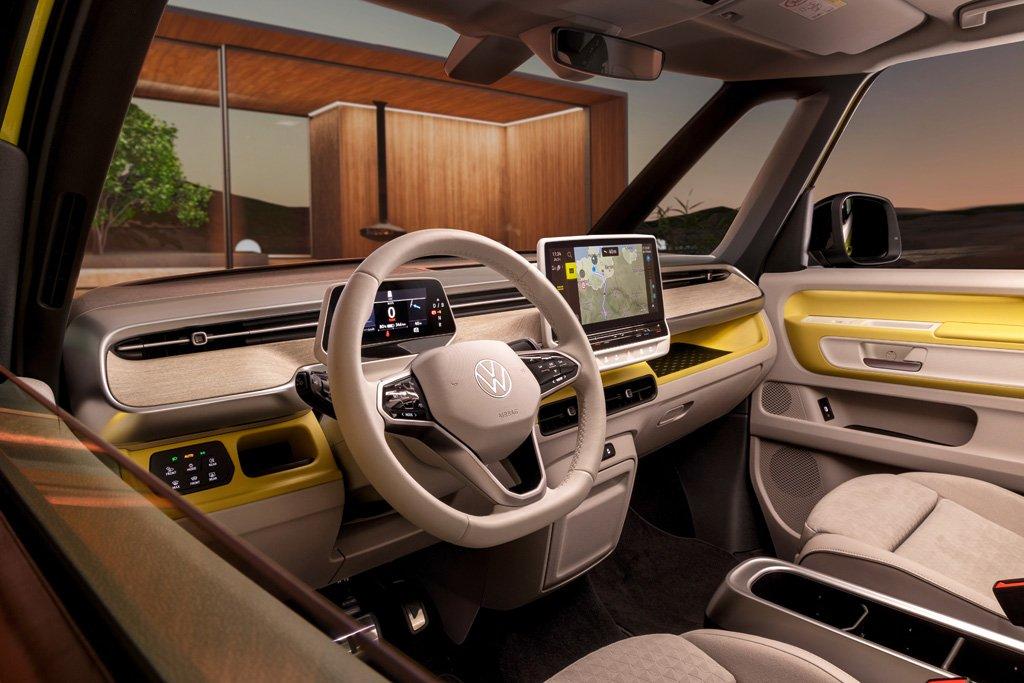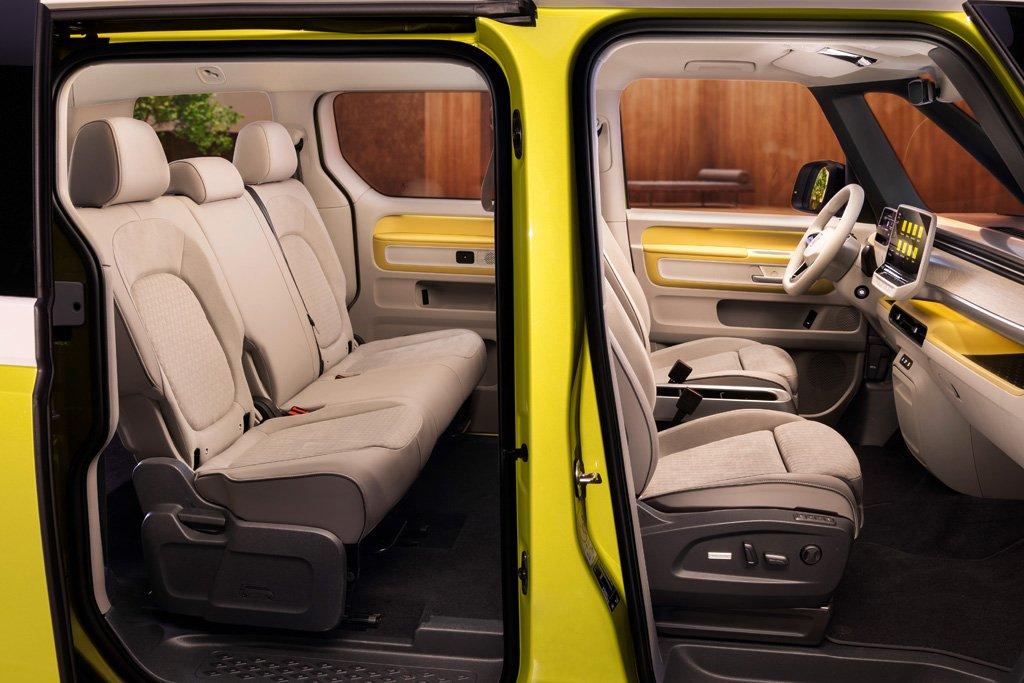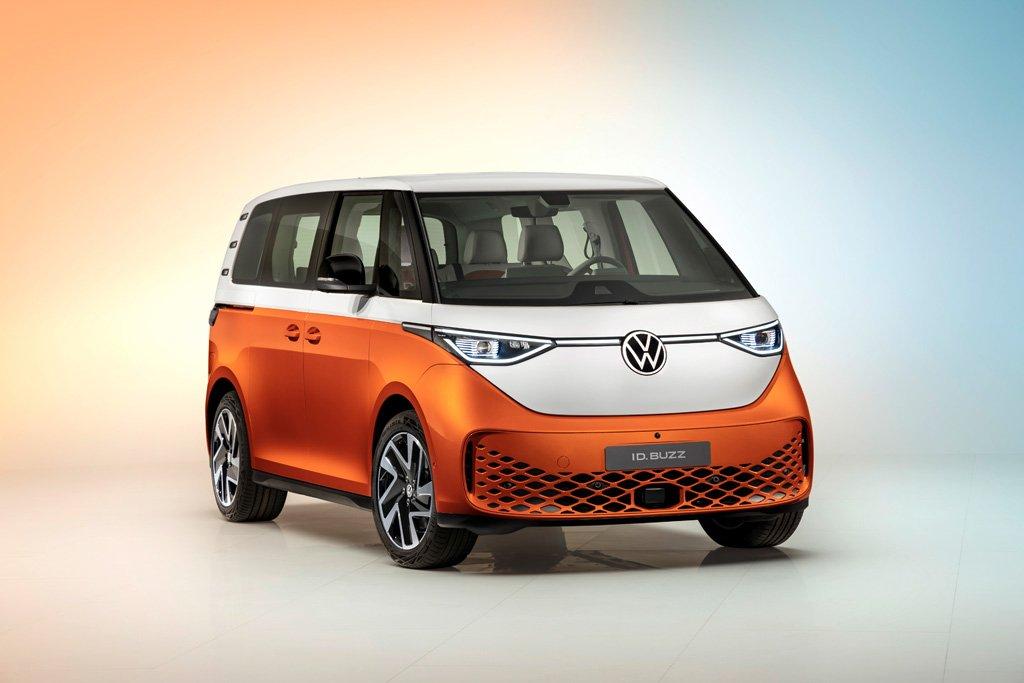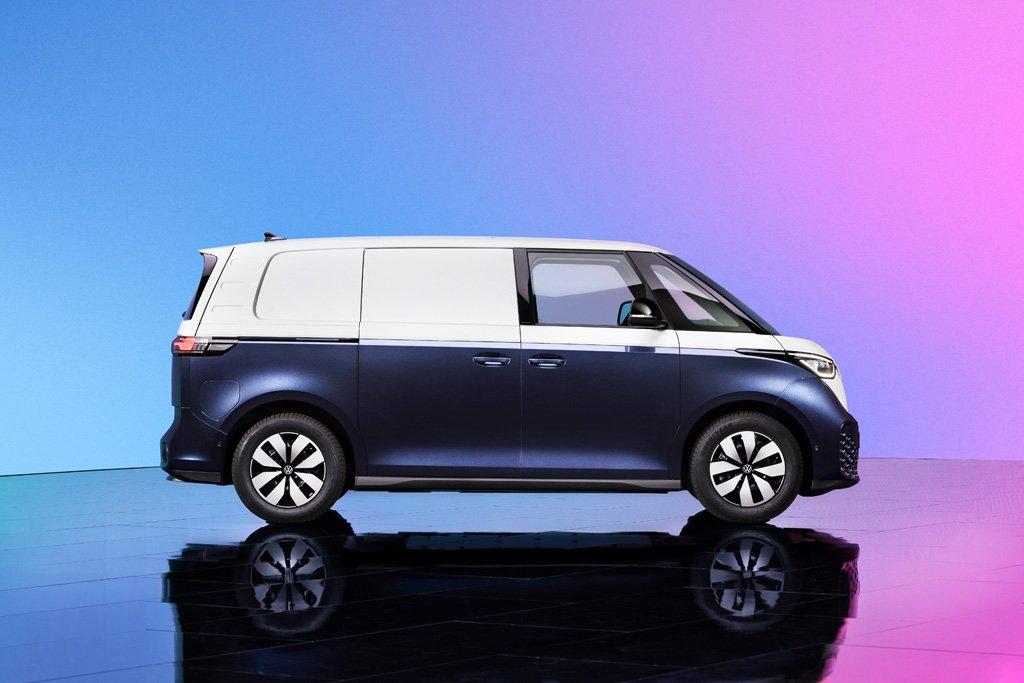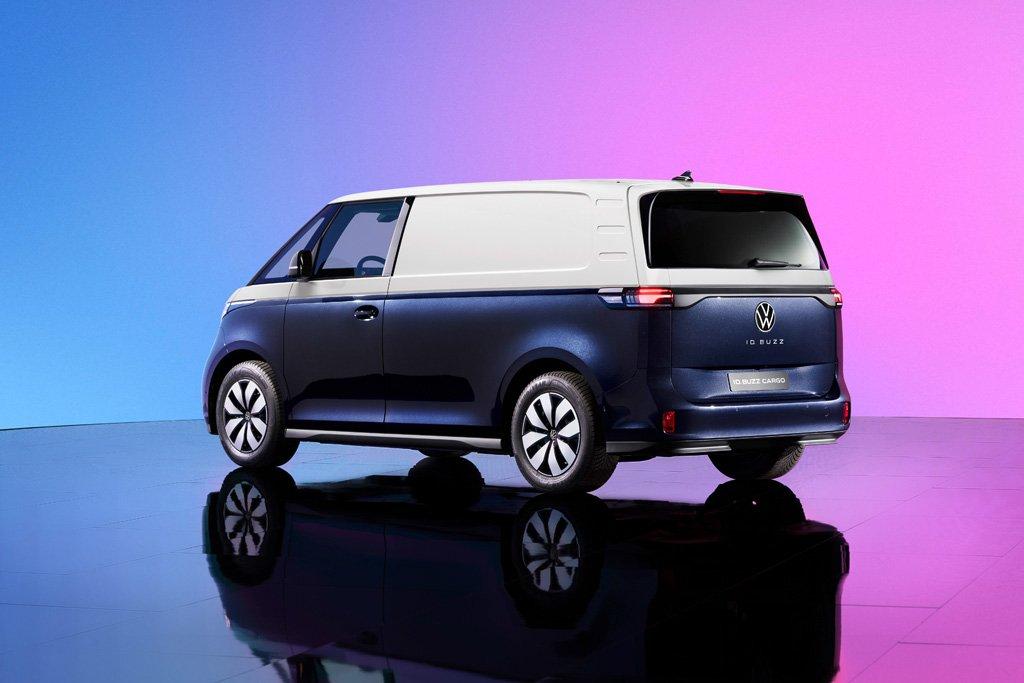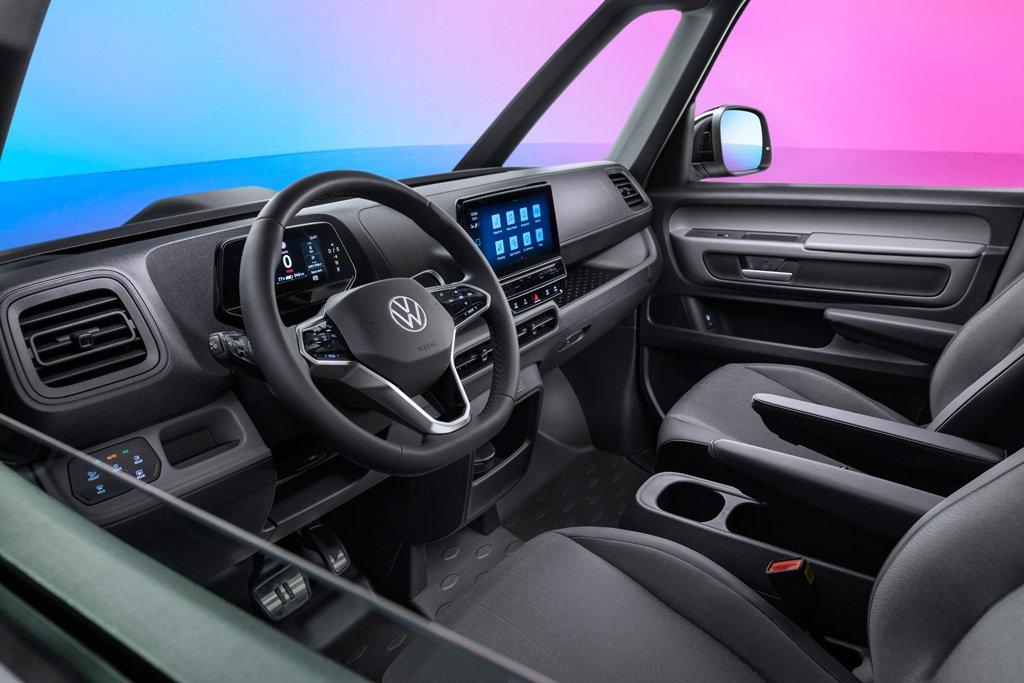Volkswagen reveals ID. Buzz electric microbus alongside commercial ID. Buzz Cargo variant
10 Mar 2022|3,584 views
Volkswagen has revealed the long-awaited ID. Buzz microbus alongside a commercial ID. Buzz Cargo variant.
Built atop Volkswagen's Modular Electric Drive Kit, the ID. Buzz sports a 2,988mm wheelbase, close to that of the current T6.1 campervan. Total body length, width, and height meanwhile, stands at 4,712mm, 1,938mm and 1,985mm respectively for the ID. Buzz.
In spite of the vehicle's generous proportions, manoeuvrability in the ID. Buzz should not be difficult, thanks to a respectable 11.1m turning radius. And for that you have the rear mounted electric motor to thank, so there's no drive axles in the way of the steering of the front wheels (just like in the original Volkswagen T1 microbus).
And all that exterior size also translates into good room in the cabin: The ID. Buzz will offer up 1,121 litres of boot space with all five seats in place.
Fold down the second row of seats, and load capacity expands to a maximum of 2,205 litres. The ID. Buzz Cargo meanwhile, will offer up to 3,900 litres of cargo space aft of a fixed partition behind the rear seats, allowing it to swallow two loaded euro pallets loaded in transversely.

 Up to 1,121 litres of space for luggage is offered even with all five seats in place in the Volkswagen ID. Buzz As you can imagine, the original Volkswagen T1 microbus also served as the inspiration for the exterior design of the ID. Buzz. There's short front and rear overhangs on the electric microbus, a boxy shape with proportions deliberately taking after the classic car, and the V-shaped front panel and a pair of head lights (which are LED items on the modern car). And that two-tone paintwork is also available as an option.
Up to 1,121 litres of space for luggage is offered even with all five seats in place in the Volkswagen ID. Buzz As you can imagine, the original Volkswagen T1 microbus also served as the inspiration for the exterior design of the ID. Buzz. There's short front and rear overhangs on the electric microbus, a boxy shape with proportions deliberately taking after the classic car, and the V-shaped front panel and a pair of head lights (which are LED items on the modern car). And that two-tone paintwork is also available as an option.
Powering the Volkswagen ID. Buzz and ID. Buzz Cargo is a 201bhp electric motor. This motor is animated via a 77kWh (net capacity) battery, mounted low in the vehicle for a low centre of gravity for improved weight distribution (much like the flat four of the T1).
The battery can be charged at up to 11kW via an alternating current charger, while maximum charging speed via direct current stands at 170kW. Volkswagen states that at this speed, the charge state of the battery in the ID. Buzz should go from 5% to 80% in around 30 minutes.
The ID. Buzz and ID. Buzz Cargo will arrive in European markets in the third quarter of 2022.
Built atop Volkswagen's Modular Electric Drive Kit, the ID. Buzz sports a 2,988mm wheelbase, close to that of the current T6.1 campervan. Total body length, width, and height meanwhile, stands at 4,712mm, 1,938mm and 1,985mm respectively for the ID. Buzz.
In spite of the vehicle's generous proportions, manoeuvrability in the ID. Buzz should not be difficult, thanks to a respectable 11.1m turning radius. And for that you have the rear mounted electric motor to thank, so there's no drive axles in the way of the steering of the front wheels (just like in the original Volkswagen T1 microbus).
And all that exterior size also translates into good room in the cabin: The ID. Buzz will offer up 1,121 litres of boot space with all five seats in place.
Fold down the second row of seats, and load capacity expands to a maximum of 2,205 litres. The ID. Buzz Cargo meanwhile, will offer up to 3,900 litres of cargo space aft of a fixed partition behind the rear seats, allowing it to swallow two loaded euro pallets loaded in transversely.

Powering the Volkswagen ID. Buzz and ID. Buzz Cargo is a 201bhp electric motor. This motor is animated via a 77kWh (net capacity) battery, mounted low in the vehicle for a low centre of gravity for improved weight distribution (much like the flat four of the T1).
The battery can be charged at up to 11kW via an alternating current charger, while maximum charging speed via direct current stands at 170kW. Volkswagen states that at this speed, the charge state of the battery in the ID. Buzz should go from 5% to 80% in around 30 minutes.
The ID. Buzz and ID. Buzz Cargo will arrive in European markets in the third quarter of 2022.
Volkswagen has revealed the long-awaited ID. Buzz microbus alongside a commercial ID. Buzz Cargo variant.
Built atop Volkswagen's Modular Electric Drive Kit, the ID. Buzz sports a 2,988mm wheelbase, close to that of the current T6.1 campervan. Total body length, width, and height meanwhile, stands at 4,712mm, 1,938mm and 1,985mm respectively for the ID. Buzz.
In spite of the vehicle's generous proportions, manoeuvrability in the ID. Buzz should not be difficult, thanks to a respectable 11.1m turning radius. And for that you have the rear mounted electric motor to thank, so there's no drive axles in the way of the steering of the front wheels (just like in the original Volkswagen T1 microbus).
And all that exterior size also translates into good room in the cabin: The ID. Buzz will offer up 1,121 litres of boot space with all five seats in place.
Fold down the second row of seats, and load capacity expands to a maximum of 2,205 litres. The ID. Buzz Cargo meanwhile, will offer up to 3,900 litres of cargo space aft of a fixed partition behind the rear seats, allowing it to swallow two loaded euro pallets loaded in transversely.

 Up to 1,121 litres of space for luggage is offered even with all five seats in place in the Volkswagen ID. Buzz As you can imagine, the original Volkswagen T1 microbus also served as the inspiration for the exterior design of the ID. Buzz. There's short front and rear overhangs on the electric microbus, a boxy shape with proportions deliberately taking after the classic car, and the V-shaped front panel and a pair of head lights (which are LED items on the modern car). And that two-tone paintwork is also available as an option.
Up to 1,121 litres of space for luggage is offered even with all five seats in place in the Volkswagen ID. Buzz As you can imagine, the original Volkswagen T1 microbus also served as the inspiration for the exterior design of the ID. Buzz. There's short front and rear overhangs on the electric microbus, a boxy shape with proportions deliberately taking after the classic car, and the V-shaped front panel and a pair of head lights (which are LED items on the modern car). And that two-tone paintwork is also available as an option.
Powering the Volkswagen ID. Buzz and ID. Buzz Cargo is a 201bhp electric motor. This motor is animated via a 77kWh (net capacity) battery, mounted low in the vehicle for a low centre of gravity for improved weight distribution (much like the flat four of the T1).
The battery can be charged at up to 11kW via an alternating current charger, while maximum charging speed via direct current stands at 170kW. Volkswagen states that at this speed, the charge state of the battery in the ID. Buzz should go from 5% to 80% in around 30 minutes.
The ID. Buzz and ID. Buzz Cargo will arrive in European markets in the third quarter of 2022.
Built atop Volkswagen's Modular Electric Drive Kit, the ID. Buzz sports a 2,988mm wheelbase, close to that of the current T6.1 campervan. Total body length, width, and height meanwhile, stands at 4,712mm, 1,938mm and 1,985mm respectively for the ID. Buzz.
In spite of the vehicle's generous proportions, manoeuvrability in the ID. Buzz should not be difficult, thanks to a respectable 11.1m turning radius. And for that you have the rear mounted electric motor to thank, so there's no drive axles in the way of the steering of the front wheels (just like in the original Volkswagen T1 microbus).
And all that exterior size also translates into good room in the cabin: The ID. Buzz will offer up 1,121 litres of boot space with all five seats in place.
Fold down the second row of seats, and load capacity expands to a maximum of 2,205 litres. The ID. Buzz Cargo meanwhile, will offer up to 3,900 litres of cargo space aft of a fixed partition behind the rear seats, allowing it to swallow two loaded euro pallets loaded in transversely.

Powering the Volkswagen ID. Buzz and ID. Buzz Cargo is a 201bhp electric motor. This motor is animated via a 77kWh (net capacity) battery, mounted low in the vehicle for a low centre of gravity for improved weight distribution (much like the flat four of the T1).
The battery can be charged at up to 11kW via an alternating current charger, while maximum charging speed via direct current stands at 170kW. Volkswagen states that at this speed, the charge state of the battery in the ID. Buzz should go from 5% to 80% in around 30 minutes.
The ID. Buzz and ID. Buzz Cargo will arrive in European markets in the third quarter of 2022.
Latest COE Prices
August 2025 | 1st BIDDING
NEXT TENDER: 20 Aug 2025
CAT A$102,009
CAT B$123,498
CAT C$70,001
CAT E$122,334
View Full Results Thank You For Your Subscription.





